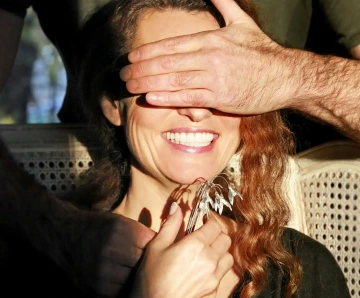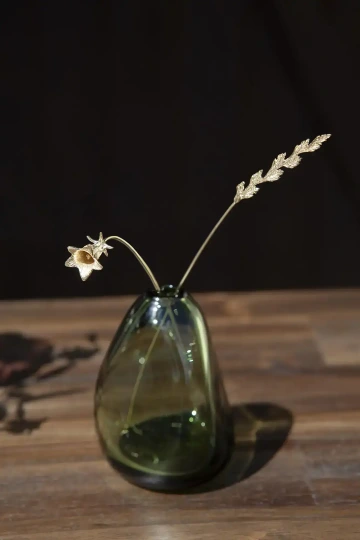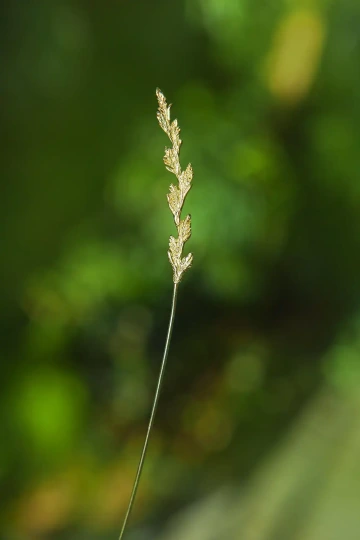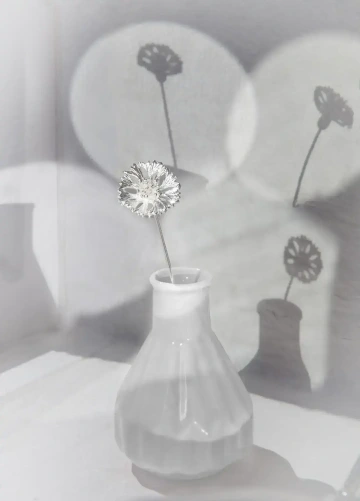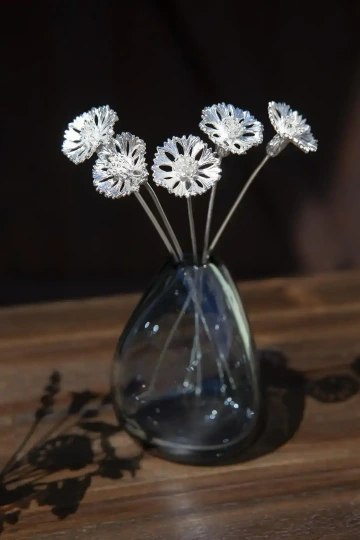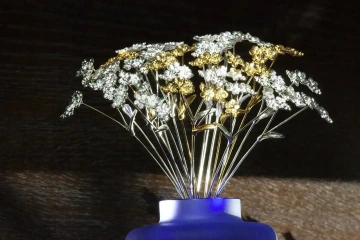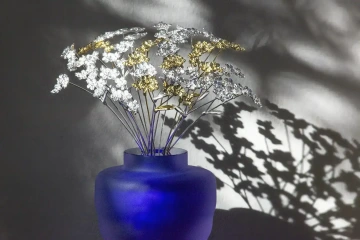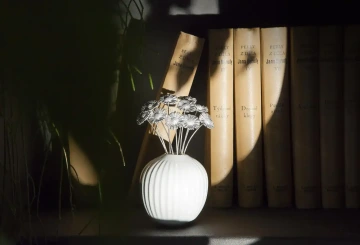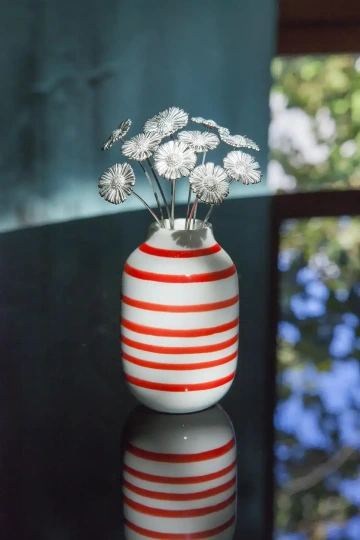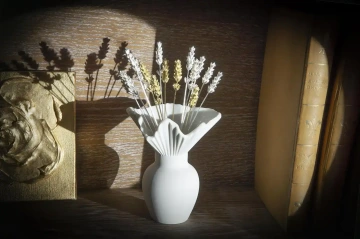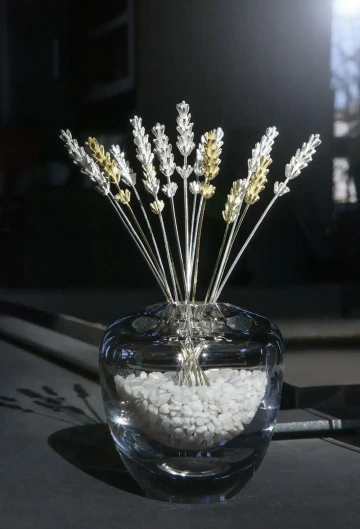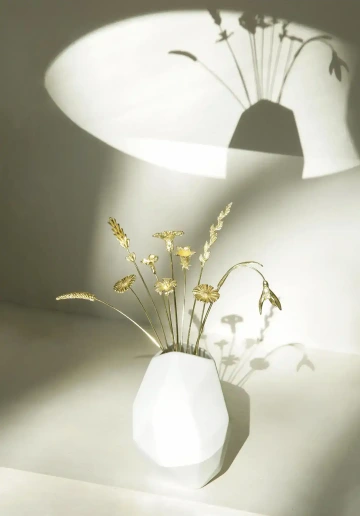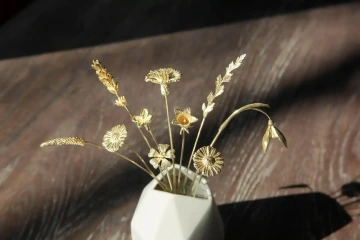Feminine and flower world of Mucha and visit of Prague
April 28, 2025
Alfons Mucha (1860–1939) was the face of French Art Noveau movement and a remarkable figure in the Czech and international art scene, gifted in numerous artistic disciplines - painting, sculpture, architecture, theatre, or furniture and jewellery design. Learn more about Mucha’s world of women and flowers, or where in Prague you can see Mucha and other hidden treasures.
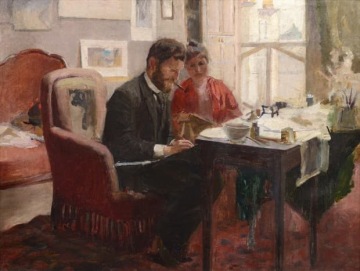
Photo: A self-portrait of Alfons Mucha, drawing in his Parisian studio, with a pipe. Courtesy of Wikipedia
Alphonse Mucha
Alfons Mucha, his art and tribute to beauty
He made no difference between painting, design, and advertising. His work was a tribute to beauty. The world is especially familiar with his graphic arts, posters, and applied arts (labels, vignettes, stickers, calendars). He was one of the few artists ever to be recognised while still alive, and is famous to this day.
In the 19th century, only the social elite had access to art. Mucha, however, believed that art should be accessible to all, regardless of social standing. It’s no wonder, then, that he made his name doing what could be called paintings of the streets -posters.
Mucha’s feminine, flower-filled worlds
Women and the beautiful female body were the pivot of Mucha’s work. He almost always portrayed them as beautiful or innocent beings in robes, with long flowing hair. He pictured women as demi-goddesses surrounded with flowers and symbols, with no awareness of worldly pains.
Mucha would portray flowers just as often, one of the most characteristic features of his style -be they held, woven into a woman’s hair, or otherwise incorporated.
The Seasons, 1896
When creating his panels, Mucha pursued six main subjects—The Seasons (1896), The Flowers (1898), The Arts (1898), The Times of the Day (1899), The Precious Stones (1900), The Moon and the Stars (1902).
One of Mucha’s most popular series, The Seasons of 1896, captures the changing mood of the seasons, using four female figures. Personifying the four seasons was nothing new but Mucha breathed a new life into the subject.
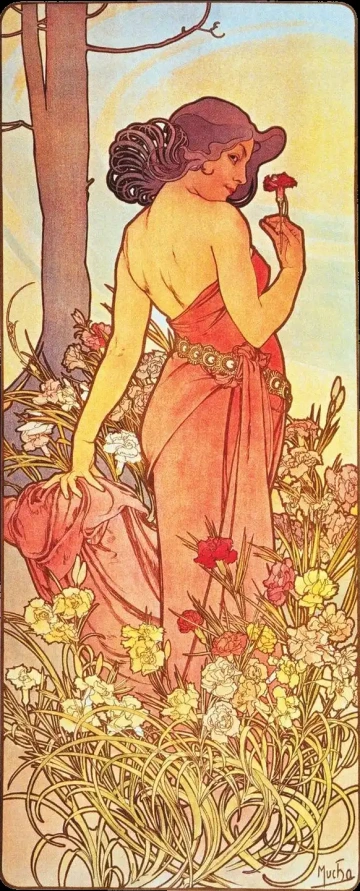
Flowers, 1898
Mucha’s Flowers distinctly personifies four flowers - the rose, iris, carnation, and lily, portraying them as women, with hairdos reminiscent of petals and leaves of the real-life counterparts.
Carnation: A female face with a slight smile; partially exposed back and neck; a red dress. The female figure holds a red carnation by her face and is surrounded by more carnations of different colours which correspond with the various emotions evoked by the painting. The word carnation is derived from the Latin term carnis, meaning body.
Lilly: A young woman with narrowed eyes and a peculiar spiritual expression, holding one lily in her hand while surrounded by more, as though she’s just another flower among many. The lilies frame her face, evoking the image of a crown. White lilies symbolise purity and are associated with maternity. Legend has it that the first lily sprung from Eve’s tears when she learned she was about to become a mother.
Rose: A woman with a confident expression, holding two roses, with more decorating her hair and surrounding her. The roses in the painting are different colours, in full bloom or buds. The rose symbolises love and beauty, but the particular meaning changes depending on the colour.
Iris: A blonde woman, decorated with opulent jewellery, with heavy-lidded eyes, her head turned turned to the side, the top of her simple dress sliding down her shoulder. Irises have long stalks and come in purple or blue. The iris is considered the holy symbol of the Virgin Mary, and also considered a sign of good news from gods.
Photo: Series The Flowers, Carnation, 1898, source Mucha Foundation, courtesy of Wikipedia.
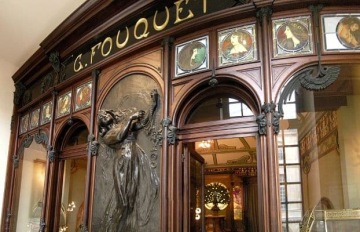
Mucha’s jewellery, Fouquet, and Parisian boutique
Mucha’s jewellery is nowhere near as well-known as his posters. The renowned French jeweller George Fouquet once saw Mucha’s poster Medea (1898) and noticed the snake-shaped bracelet on Medea’s wrist. A year went by and the jeweller created a bracelet just like the one in Mucha’s poster, for Sarah Bernhardt. Subsequently, Mucha designed a number of jewellery pieces for the actress. Mucha himself created only a limited number of pieces, mostly in cooperation with Fouquet.
The cooperation resulted in the establishing of Fouquet’s boutique in Rue Royale whose exterior and interior Mucha designed. In 1941, Fouquet gave the jewellery to Musée Carnavalet in Paris for safekeeping.
You can see Mucha’s jewellery here.
Photo: The façade of Georges Fouquet’s jewellery-store in Rue Royale 6 in Paris, designed in 1901 by Mucha in his capacity as a project manager of the Jansen company which hired Léon Fargus to make the stained glass. In 1923, it was taken apart. Musée Carnavalet (Paris). Courtesy of Wikipedia. Autor: O.Taris
Where you can find Mucha in Prague
Ivan Lendl’s collection of Mucha’s posters, the largest one in Czechia
Mucha’s posters can be found in the collections of numerous museums and private collectors. But one in particular is regarded especially highly. In the 1980s Ivan Lendl, a Czechoslovakia-born world-renowned tennis player, bought his first Mucha poster - Gismonda - and then with the help of the curator Jack Rennert went on to collect more, compiling them into the most compact collection of Mucha’s posters there was. In 2013, Richard Fuxa, another Czech, bought it from Ivan Lendl and has continued to add other works by Mucha ever since.
Under Lendl’s ownership, the collection was exhibited for public viewing in 1986 in Tokyo (the (Matsuzakaya Museum), in 1989 in Paris (Museé de Publicité); under Fuxa, in 2013 in Prague (Municipal House), in 2015 in Milan (Palazzo Reale), in 2016 in Genoa (Palazzo Ducale), in 2019 in Soul, and in 2020 once again in the Municipal House in Prague.
Walking in Mucha’s footsteps
If you admire Mucha’s art and happen to be visiting Prague or are planning a visit, you can walk in Alfons Mucha's footsteps, by all means on your own. There are four tours for you to choose from - Following the Trail of Mucha’s Design, Mucha’s Prague, Alfons Mucha - The Greatest Czech Art Noveau Painter, or In the Footsteps of Alfons Mucha.
In the Prague district of Bubeneč (approximately a 15-minute taxi ride from the city centre), there’s a house Mucha had commissioned in the 1920s. It’s privately owned and not open to the public.
The Municipal House in Prague
At the Municipal House, an Art Noveau building located in the centre of Prague in the Republic Square, you can see Mucha’s work in the form of murals. The building is one of the most important structures of the Prague Art Noveau movement, and multiple artists took part in decorating it. In 1909, Mucha was commissioned to make murals for the house’s Mayor’s Hall.
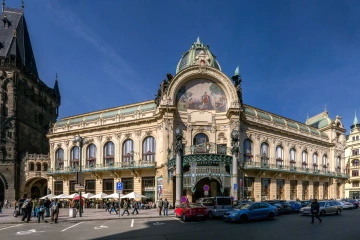
Photo: Jugendstil Prague Gemeindehaus, Thomas Ledl – Own work, CC BY-SA 4.0, Courtesy of Wikipedia
Stained glass at the St. Vitus Cathedral
If you happen to be walking around the Prague Castle, definitely visit the St. Vitus Cathedral and take a look at its stained glass windows. The remarkable colourful artistic panels were made from 1865 to 1969, using models from prominent Czech artists.
The Prague Castle also features the largest artistic cathedral window - The Last Judgement, with the surface area of 160 m2, made according to a design by Max Švabinský. Other stained glass windows used the designs by C. Bouda, F. Kysela, K. Svolinský, or Alfons Mucha.
Mucha’s window depicts Saint Wenceslas in childhood, as well as Saint Ludmila of Bohemia, and the theologians Cyril and Methodius. It’s located in the cathedral’s northern nave.
The windows need to be periodically restored. This is the job of the Prague artistic glassmakers’ workshop where the stained glass was originally made decades ago.
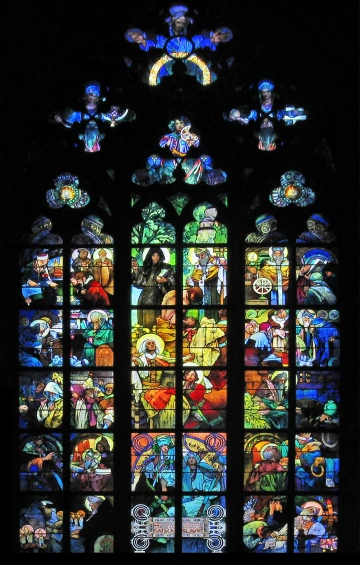
The Mucha museums in centre of Prague
In the center of Prague you can visit two museums dedicated to Mucha - the museum in Panská Street and the museum in Na Příkopě:
The Mucha Museum at the Kaunitz Palace
The Mucha Museum at the Kaunitz Palace, established in 1998, is devoted to the life and work of Alfons Mucha. As of 2024, it exhibits items from the Ivan Lendl collection—posters from Mucha’s Paris period or his commissions for such companies as Moët & Chandon, Job Cigarettes, or Lefèvre-Utile Biscuits. There are six tours to choose from.
Mucha Museum, Kaunitz Palace, Panská 7, Prague 1, www.mucha.cz, opened ever day from 10:00 a.m. to 6:00 p.m.
The Mucha Museum at the Savarin
The museum was established in 2025 at the Savarin, a Baroque palace of the Sylva-Taroucca family. The museum is funded by the Mucha Foundation and Mucha’s family. The three halls show works by Alfons Mucha, including reproductions of the Slav Epic. The Savarin exhibition, containing roughly 150 exhibits, was set up by the Japanese-British curator Tomoko Sato.
Mucha Musem at the Savarin, Savarin Palace, Na Příkopě 852/10, Prague 1, www.mucha.eu, opened daily from 10:00 a.m. to 6:00 p.m.
The Slav Epic and its transfer
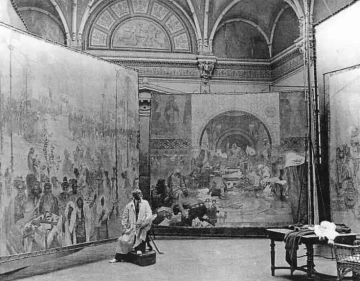
Mucha’s Slav Epic
In 1900, Mucha decided to spend the rest of his life working on a monumental cycle of paintings to explore the historic roots of the Slavs. He conducted a thorough research—read historic sources, consulted historians, and drew thousands of studies. The Slav Epic consists of twenty paintings.
A debate has raged for years regarding where the Epic should be exhibited permanently. Mucha wished to donate the cycle to Prague but the city never secured suitable exhibition grounds for it.
Moving the Epic’s and an unclear future
From 1950, the Slav Epic had been exhibited at the Moravský Krumlov castle in Bohemia. Later, proposals were made to move the Epic to Prague but the project turned out to be too complicated. In 2012, the Epic was exhibited in the Prague City Gallery for the very first time. In 2017, the contract with Prague expired and the paintings travelled to Asia. From Japan, they were supposed to travel to an exhibition in China but the Ministry of Culture of the Czech Republic didn’t approve the transfer and in 2019 the Epic moved back to Moravský Krumlov. A removal to the Savarin basement is being debated but nothing’s certain.
Photo: Mucha works on the Slav Epic, 1920, author unknown. Courtesy Wikipedia.
Discovering other hidden gems of Prague
Both Mucha museums are located 1-3 minutes walk from GIYOU GARDEN. So you can combine a tour of Mucha's work with a tour of the unusual garden of flowers made of silver and gold. And in addition to Mucha's irises, carnations, lilies and roses, you can explore Czech jewelry snowdrops, daisies, ryegrass, cornflowers, lavender, etc., which you will not see anywhere else but in Prague.
GIYOU
info@giyou.cz

